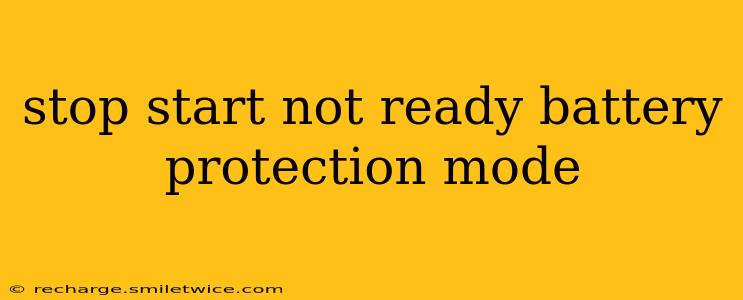Many modern vehicles use a Stop-Start system to improve fuel efficiency. This system automatically shuts off the engine when the vehicle is stopped (e.g., at a red light) and restarts it when needed. However, sometimes you'll encounter a "Stop Start Not Ready" message, often accompanied by "Battery Protection Mode." This indicates the system has deactivated itself to protect the battery. Let's delve into the reasons behind this and how to troubleshoot it.
What Does "Stop Start Not Ready Battery Protection Mode" Mean?
This message means your car's battery doesn't have enough charge to reliably handle the repeated starting and stopping cycles of the Stop-Start system. To prevent the battery from completely draining, the system disables itself, switching to Battery Protection Mode. This ensures the battery remains charged enough for essential functions like starting the engine and powering electrical components. Think of it as the system's way of saying, "Hold on, I need more juice before I can start and stop repeatedly."
Why is My Stop-Start System Deactivated?
Several factors can trigger the "Stop Start Not Ready Battery Protection Mode" message:
-
Low Battery Charge: This is the most common cause. A weak or aging battery might not have enough reserve power to handle the demands of the Stop-Start system. Short trips, frequent use of electrical components (lights, radio, heated seats), and leaving accessories on when the car is off can all contribute to a low charge.
-
Faulty Battery: An old or defective battery, even if it shows a seemingly acceptable voltage, might not be able to deliver the necessary current for quick restarts. Internal damage or sulfation can significantly reduce its performance.
-
Faulty Alternator: The alternator charges the battery while the engine is running. A malfunctioning alternator might not be adequately recharging the battery, leading to low charge and triggering the protection mode.
-
High Electrical Load: Using energy-intensive features like heated seats, air conditioning, or multiple electronic devices simultaneously can drain the battery faster than the alternator can recharge it, especially during short trips.
-
Cold Weather: Cold temperatures significantly reduce a battery's ability to deliver current. This can easily lead to the Stop-Start system deactivating itself.
-
Parasitic Drain: A small but persistent drain on the battery (caused by a faulty component or a constantly active accessory) can slowly deplete the battery's charge over time.
How Can I Fix the "Stop Start Not Ready" Problem?
Troubleshooting this issue involves systematically checking the potential causes:
1. Charge the Battery:
If you suspect a low charge, use a battery charger to fully charge the battery. After charging, try the Stop-Start system again. If the problem persists, more investigation is necessary.
2. Check the Battery's Health:
A battery load test performed at an auto parts store or mechanic will determine if the battery is still healthy enough for the demands of your vehicle. If the test indicates a faulty battery, it's likely time for a replacement.
3. Inspect the Alternator:
A mechanic can test your alternator to ensure it's charging the battery correctly. A faulty alternator needs to be replaced.
4. Reduce Electrical Load:
Try to minimize the use of power-hungry features, particularly during short journeys. Switching off unnecessary electronics can help conserve battery power.
5. Address Parasitic Drains:
A mechanic can help identify any parasitic drains on your battery, fixing any faulty components causing the drain.
6. Drive Longer Distances:
Frequent short trips prevent the battery from fully recharging. Try to incorporate longer drives into your routine to give the alternator ample opportunity to replenish the battery's charge.
What if the Problem Persists?
If you've tried these steps and the problem continues, it's best to consult a qualified mechanic. They have the tools and expertise to diagnose more complex issues related to the Stop-Start system or your vehicle's electrical system.
Frequently Asked Questions (FAQ)
Q: Can I disable the Stop-Start system permanently?
A: Some vehicles allow you to permanently disable the Stop-Start system through the vehicle's settings menu. Consult your owner's manual for instructions specific to your car model. However, keep in mind that disabling this feature will reduce your fuel economy.
Q: Is it harmful to constantly ignore the "Stop Start Not Ready" message?
A: While not immediately catastrophic, repeatedly ignoring this message can lead to a flat battery, leaving you stranded. The Stop-Start system is designed to protect the battery, so heeding its warning is important.
Q: How often should I check my car's battery?
A: It's advisable to have your battery checked at least once a year, or more frequently if you experience issues like frequent short trips, extreme weather, or noticeable changes in your vehicle's performance.
By understanding the causes and troubleshooting steps, you can effectively address the "Stop Start Not Ready Battery Protection Mode" message and ensure your vehicle runs smoothly. Remember, proactive maintenance is key to preventing such issues.
